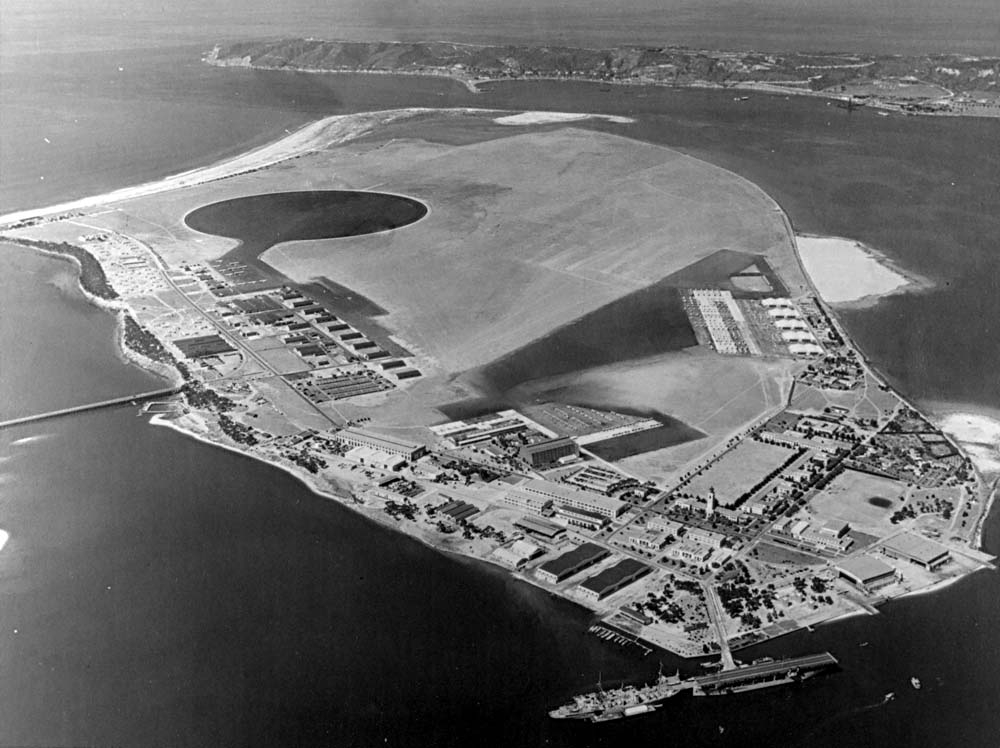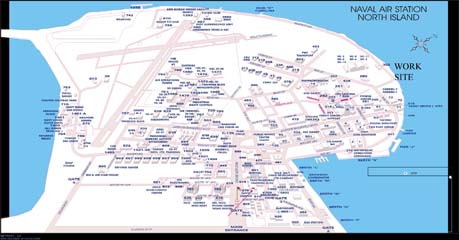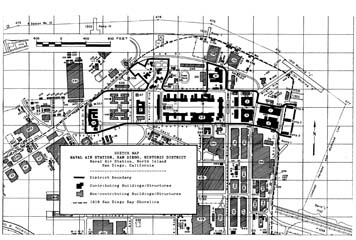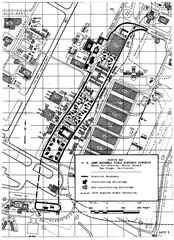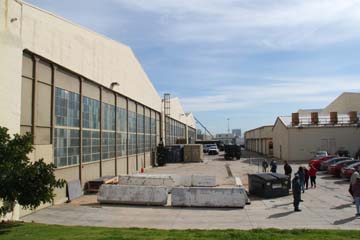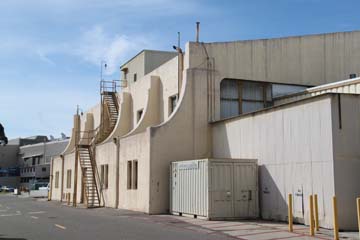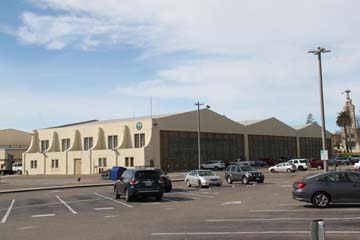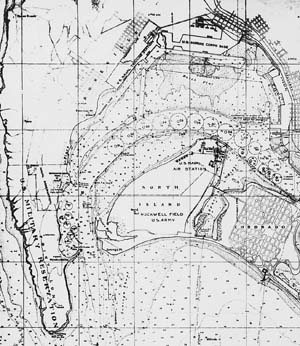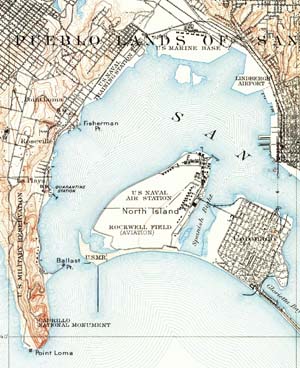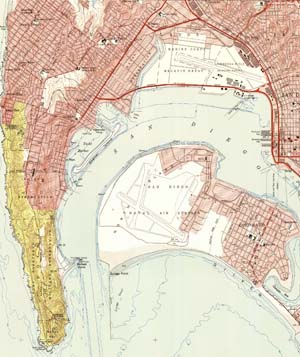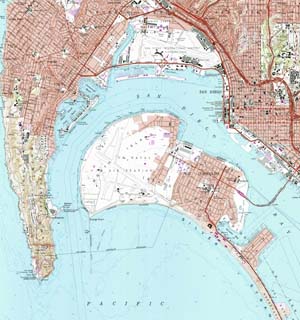|
North Island Naval Base
by Steve Schoenherr
North Island, August 1933
See pictures from the NAS Tour Feb. 8
North Island Chronology 1542-1966from Elretta Sudsbury, Jackrabbits to Jets1542 - Juan Rodrigues Cabrillo sailed into "Port of San Miguel," now known as San Diego Bay, and took possession of the area for Spain. He described North Island as covered with lemonadeberry or mahogany trees. 1793 - Fort Guijarros, the first military establishment in San Diego, was established on Ballast Point. The soldiers hauled water from the spring on the western end of North Island near the Whaler's Bight. 1803 - American trading and whaling vessels were first based in San Diego. Hide warehouses were located on Point Loma. Crews from the hide vessels would row to North Island to take water from the spring. May 5, 1846 - Governor Pio Pico of California, in the name of the Mexican nation, granted to Don Pedro Cabrillo the tract of land now known as North Island, Coronado, and the Silver Strand. October, 1846 - Beezer Simmons bought the land for $1,000 in silver. June 28, 1850 - Mr. Simmons sold his holdings to five buyers. June 11, 1869 - The claim of Archibald C. Peachy and William H. Aspinwall to North Island, Coronado, and the Silver Strand was approved by the Commissioner of the General Land Office as part of the settling of land grants which took place after California was admitted to the Union. 1873 - Charles F. Holley bought the land for $110,850. 1877 - George Graness bought the peninsula for $116,338.68. 1886 - E. S. Babcock and H. L. Story bought the peninsula for $100,000. 1888 - Coronado Beach Company was formed with controlling interest held by John D. Spreckels. Development of Coronado and building of Hotel del Coronado was pushed. North Island was not developed. 1893 - 18.05 acres of the extreme southwest tip of the Island were condemned for construction of a jetty to keep the San Diego channel open. Construction began in 1894. 1901 - 38.56 acres known as Zuniga Shoal Tract adjacent to the jetty were condemned for the purpose of establishing a coast defense fort, Pio Pico, a substation of Fort Rosecrans. This was the first military reservation on North Island. January 23, 1910 - Charles K. Hamilton flew a Curtiss "pusher" from the Coronado Polo Grounds to make the first powered flight in San Diego county. January 25, 1910 - Charles K. Hamilton flew a Curtiss pusher from the Coronado Polo Grounds and made an emergency landing on North Island. This was the first airplane ever to land on North Island. January 17, 1911 - Lieutenant T. G. Ellyson reported to the Glenn Curtiss Aviation Camp on North Island to begin flight instruction. Ultimately he became Naval A viator Number One. The "school" had three Army officers, one Navy Officer (Ellyson), and two civilians. The Curtiss School and Experimental Station operated three years. January 26, 1911 - The first successful seaplane flight in the United States was made by Glenn Curtiss from the Spanish Bight off North Island. February 17, 1911 - Glenn Curtiss launched his hydroaeroplane from North Island and came alongside the Cruiser USS PENNSYLVANIA in San Diego Bay. He was hoisted aboard by ships crane, lowered back to the water, then taxied to North Island. This provided further proof that aeroplanes could be adaptable for Navy use. February 25, 1911 - Glenn Curtiss at North Island made the first successful amphibian flight. January 15, 1912 - Lieutenant T. G. Ellyson arrived on North Island to establish an aviation camp for the Navy. Within days, the entire flying Navy - four officers, nine enlisted men, and three airplanes were aboard. They remained until May 3, 1912. While at North Island, they conducted wireless experiments, gave flight instruction, practiced flying, and experimented with new type floats. November 4, 1912 - The first detachment of Army Signal Corps arrived at North Island to establish an aviation camp at the invitation of Glenn Curtiss. Ultimately this operation grew into Rockwell Field. The Army Camp was located on the northeast corner of North Island and along the bay. The Army was at North Island continuously from that point until the final phase-out of Rockwell Field in 1939. Mid-1913 - All Army aviation was located at North Island. By December, 1913, there were 20 officers on duty. The unit had been designated "Signal Corps A viation School." July 3, 1914 - The 4th Regiment, U. S. Marine Corps, under Colonel Joseph H. Pendleton, went ashore at North Island and began establishing a camp known as Camp Howard. Ultimately this operation grew into what is now Marine Corps Recruit Depot. The entire 4th Regiment of over 1100 officers and men were at North Island in the beginning. The outpost dwindled until by 1916, only two men remained. The rifle range continued to be manned until MCRD was commissioned. September, 1914 - The Army First Aero Squadron was organized at North Island under the direction of Captain Benjamin D. Foulois. This unit represented the tactical air strength of the Army during the years immediately preceding World War I. The First Aero Squadron was the first flying unit from America to reach France in World War I. May 5, 1917 - A joint Army/Navy Board recommended that North Island be obtained for joint use of the Army and Navy Air Services. July 27, 1917 - The President approved an act to take possession of North Island by the Federal Government for use in National Defense as a site for a permanent aviation school. August 11, 1917 - The Commanding Officer of Rockwell Field was directed by the War Department to assume control of the whole of North Island in the name of the United States. At that time, sole occupancy was held by the Army except for the Marine Railway operated by the Spreckels interests. August 16, 1917 - Joint tenancy plans and agreements were drawn up by the Commanding Officer of Rockwell Field, acting for the War Department, and the Commanding Officer of the Naval Training Camp, San Diego, representing the Navy. September 25. 1917 - Lieutenant Earl W. Spencer, USN, was ordered to duty in command of Naval Air Station, San Diego. He was directed to report to the Commanding Officer, Naval Training Station, San Diego for duty on or about October 15, 1917, to establish a permanent Naval Air Station for training purposes. November 8, 1917 - Lieutenant Earl W. Spencer reported to San Diego to establish and serve as Commanding Officer of the Naval Air Station on North Island. This date has been accepted as the official beginning date of Naval Air Station, North Island. January 14, 1918 - A boundary compromise agreement was reached between the Army and Navy so the Navy occupancy of the northeast corner of North Island could begin. Rockwell Field was relocated entirely to the south side of the Island. February 1, 1918 - B y this date, the Navy had custody of two temporary barracks, the Post Exchange Building, and four seaplane hangars - all temporary buildings sold them by the Army. Work of erecting the first airplane, a Burgiss U-2, began. Curtiss R-6s had also arrived and Curtiss N-9s were enroute. March 16, 1918 - The permanent dividing line between Rockwell Field and the Naval Air Station was approved by Franklin D. Roosevelt, Acting Secretary of the Navy, and Newton D. Baker, Secretary of War. June 1, 1918 - An Army/Navy causeway from Coronado to North Island was completed. This 3,050 foot bridge began at 4th street in Coronado and ended one block south of the dividing line between Army and Navy property. June 14, 1918 - The Navy gained total possession of the north end of North Island. Formal transfer took place June 17. Officers and men were moved from temporary quarters in Balboa Park to North Island. Full scale operation began - a mechanics school and flight school. July 23, 1918 - Plans for the permanent Air Station were completed by Commander L. M. Cox, 12th Naval District Public Works Officer, who served as Officer in Charge of Construction. October 16, 1918 - The Navy and Army staged a flyover of 115 airplanes to promote Liberty Bond sales. November 11, 1918 - By the war's end, NAS San Diego had trained 892 mechanics, and 206 aviators.
During 1918, Bertram Grosvenor Goodhue deisgned the first buildings in what is now the Naval Air Station Historic District,
including these Seaplane Hangars (Buildings 1 and 2). More pictures of the district are at the NAS Tour page. November 27, 1918 - T h e Army and Navy staged a flyover of 212 airplanes to demonstrate the growing supremacy of American aviation which had helped to win the war. December 4, 1918 - Army Major A. D. Smith in command of five JN-4H airplanes, left Rockwell Field on a transcontinental mapping flight. They returned January 15, 1919. 1919 - The first civilians were hired at North Island - clerical and laborers. April 13, 1919 - The grand opening of the Dirigible Hangar (known as Balloon Hangar, Building 17, now demolished) was marked by a barbecue and dance. The Station was designated as a base for LTA at that time as well as seaplanes. June, 1919 - The Pacific Fleet was reestablished. July 15, 1919 - An Assembly and Repair Officer was designated, thus the aircraft erection and repair function became a separate department. Until then, it had operated informally. August 7, 1919 - The Pacific Fleet arrived in San Diego, under the command of Admiral Hugh Rodman. The flagship was the USS NEW MEXICO. The welcoming party included Navy Secretary Josephius Daniels. October, 1919 - Air Detachment, Pacific Fleet, was established with Captain James A. Tomb, Commanding Officer of the minelayer USS AROOSTOOK, as the first Commander. The initial aircraft for outfitting the Air Detachment were six F-5-L, four Curtiss JNs borrowed from Rockwell Field, two Hanroit Scouts, two Sopwith Camels, and two Sopwith I-1/2 Strutters. The AROOSTOOK was flagship. North Island was homebase. December, 1919 - Seaplane airmail service was inaugurated between San Diego and San Pedro consisting of one round trip daily, except Saturday and Sunday in an F-5-L. December 31, 1919 - Ge'neral Order 514 established Naval Base, San Diego, California, consisting of NAS, Naval Fuel Depot, Naval Hospital, the Marine Barracks, the radio stations, and such other activities which then or might be established in San Diego or in the immediate vicinity. The Commandant of the Naval Base was to be an officer detailed to this duty by the Navy Department, and in his absence the senior Naval line officer in command of one of the activities within the limits of the base would assume command. March 1, 1920 - First flight of non-rigid airship C-6, the first dirigible flown in San Diego. May 18, 1920 - CNO stated that NAS, in addition to its functions as an Air Station, would eventually undertake overhaul, repair, and supply for all material for the Pacific Fleet Air Detachment. December 29, 1920 - First flight to Panama began. Twelve F-5-Ls and two NC Boats under command of Captain H. C. Mustin, Commander, Air Detachment, Pacific Fleet, undertook a round trip flight to test the efficiency of the F-5-Ls. Both NCs and one F-5-L failed to complete the flight. The 7,000 mile round trip was 109 hours, 5 minutes flying time at an average speed of 60 MPH. 1921 - Night flying was instituted. The F-5-L was equipped for night flying. Pilots transitioned in N-9s. 1921 - The seaplane launching pier adjacent to building 29 was begun. A catapult would ultimately be mounted on it so Station and Fleet pilots could be trained for battleship and cruiser duty. 1921 - The old Army/Curtiss dock on the northeast corner of the Station was torn down and Pier J constructed. 1921 - The Shipplane Practice Landing Platform was begun in 1920 and completed in 1921. The landing platform was vaguely LANGLEY shaped. It provided a way for pilots to practice for carrier landings. 1921 - North Island was directed to cease L T A activity and store or dispose of equipment. From that time forward, North Island was a terminal point for airships as a stub mooring mast, hydrogen plane, and other necessary facilities would be maintained. It was never again a base for airships. 1921 - Fleet Air Squadrons were reorganized, providing an aviation force for each fleet. North Island was homebase for Air Squadrons. Pacific Fleet, which consisted of Spotting Squadrons Three and Four, Combat Squadrons Three and Four and Seaplane Patrol Squadron One. The minelayer AROOSTOOK was flagship and tender. The minesweeper GANNET was auxiliary tender. Spotting and combat squadrons had 18 aircraft each. The seaplane squadron had six F-5-L aircraft at mid-year but was operating 12 by the end of 1921. May 22, 1922 - The North Island land, long in litigation, was settled, when Judge Advocate General sent BUAER a copy of a title. Courts had awarded Coronado Beach Company $5,000,000 and accrued interest totaling $1,098,333.33. Check for $6,098,333.33 was paid into court December 29, 1921. June, 1922 - Air Detachment, Pacific Fleet, was renamed "Aircraft Squadrons, Battle Fleet." This was part of a reorganization which would combine the Atlantic and Pacific Fleets into the U. S. Fleet, then designate the western part as the Battle Fleet and the eastern part as the Scouting Fleet. July 19, 1922 - Published mission of NAS was "Fleet Air Base for major repairs and overhaul of aircraft material assigned to Aircraft Squadrons, Battle Fleet." Training of landplane pilots for the fleet was discontinued at the end of the year. September 22, 1922 - The battleship, OKLAHOMA, was equipped with an aviation unit assigned by the Battle Fleet. One pilot, six aviation rates, and one airplane were assigned initially. Another plane and crew were assigned later that year. This was the first battleship of the Pacific Fleet to be so equipped.
1923 - The final six major structures of the permanent Naval Air Station planned in 1918 were built. The Navy stub mooring mast was erected on the Rockwell side. No more major buildings would be constructed until 1929. April 19, 1923 - First ferry flight of North Island overhauled airplanes began. It was made by four Martin bombers flown from San Diego to Quantico, Virginia. May 3, 1923 - The first non-stop coast-to-coast flight terminated at Rockwell Field. Lieutenants Oakley G. Kelly and John A. McCready flew the T-2 from New York in 26 hours, 50 minutes, a distance of 2,780 miles. June 6-12, 1923 - Thirteen world's records were established by pilots of Aircraft Squadrons, Battle Fleet. June 26, 1923 - The first complete midair pipeline refueling between two airplanes was established by Rockwell pilots in two converted DH-4s. The tanker plane was flown by Lieutenant V. Hine. Lieutenant F. W. Seifert was the operator of the fueling equipment. The receiver plane was flown by Lieutenant L. H. Smith with Lieutenant J. P. Richter acting as receiver. August 16, 1924 - The flying Marines, VO-1M, moved from Santo Domingo City, Dominican Republic, to NAS, North Island. This was the beginning of the Marine aviation activity on North Island. September 18, 1924 - The repair ship MEDUSA was commissioned. September 22, 1924 - Army Round-theWorld flyers visited Rockwell Field prior to the official completion of their flight. October 10, 1924 - The SHENANDOAH visited North Island for the first time. North Island had been designated as the West Coast terminal point for the rigid dirigible. Admiral Moffett was among the dignitaries who made the flight from Lakehurst in SHENANDOAH on her first trip west. Lieutenant Commander Zachary Lansdown was in command. November 11, 1924 - The first successful night launch from a battleship using a catapult was accomplished from CALIFORNIA anchored in San Diego harbor. Lieutenant Dixie Keifer was the pilot. November 30, 1924 - LANGLEY arrived in San Diego to join Aircraft Squadrons, Battle Fleet. Captain Stanford E. Moses, Commander, Aircraft Squadrons, Pacific Fleet, moved his pennant from the AROOSTOOK to the LANGLEY. 1925 - Aerial survey of Colorado Oil Shale reserves was done by North Island personnel. The three-plane project was headed by Lieutenant Ben H. Wyatt. April 9, 1925 - The first night landing aboard a U. S. carrier was made by Lieutenant John D. Price of VF-1 in LANGLEY at sea off San Diego. He was followed on board by Lieutenants D. L. Conley, A. W. Gordon, and R. D. Lyon. July, 1925 - Catapult training by NAS began, using the Mark 1, Type A catapult which had been installed on the AROOSTOOK pier, adjacent to Building 29 on North Beach. August 22, 1925 - Captain John Rogers departed North Island on the first leg of his flight to Hawaii. The flight of the PN-9 began in San Francisco August 31, 1925. A second PN-9 began the flight but went down at sea early in the trip. Captain Rogers' plane was forced down late on September 1 and was lost for 10 days. He and the crew rigged sails with fabric from the wings and sailed the seaplane 450 miles, to within 10 miles of their destination where they were then taken in tow by a submarine. 1926 - Marine Captain H. D. Campbell of the West Coast Expeditionary Force based at North Island was presented the Schiff Trophy by President Calvin Coolidge for attaining the highest number of flying hours of any Navy or Marine pilot during Fiscal Year 1926. He flew 839.4 hours. 1926 - Planes of the Battleship Division were color coded. The after part of the fuselage and the tail surfaces were painted the color corresponding to the top of the turret of the ship to which the plane was assigned. Planes of the Flagships were painted the colors and followed the outline of the Division Flag. The number one planes of Battleship Division Three had the forward part of the main pon-toon painted red, of Division Four, white, of Division Five, yellow. Stern of main pontoon of all number two planes were painted the same color. June 6 to September 24, 1926 - The first Alaska Survey, headed by Lieutenant Ben H. Wyatt of the Naval Air Station, was conducted. Equipment included the tender GANNET, three Loening Amphibians, and the covered barge YF-88. Over 15,000 square miles were mapped. October 22, 1926 - VF-2, commanded by Lieutenant F. D. Wagner, led the squadron of F6C-2 Curtiss fighters in a simulated dive bombing attack on the heavy ships of the Pacific Fleet as they sortied from San Pedro. This was the first fleet dive bombing demonstration. May 10, 1927 - Charles A. Lindbergh departed North Island on the first leg of his flight to Paris. August 8, 15, 16 and 18, 1927 - Lieutenants B. J. Connell and H. C. Rodd broke various world records in the PN-10. March 21, 1928 - The SARA TOGA was seen off San Diego for the first time. It stood off-shore in Coronado Roads following maneuvers with the Battle Fleet. August 16, 1928 - Station and Battle Fleet aircraft staged an aerial exhibition as part of the dedication of Lindbergh Field and to mark the 25th year of powered flight. September 8-16, 1928 - N o r t h Islandbased planes took part in the National Air Races and Aeronautical Exposition at Mines Field, Los Angeles, carrying of numerous honors. The Sea Hawks performed several times during the show. 1929 - North Island based carriers LEXINGTON and SARATOGA, the largest ships in the world, took part in fleet exercises for the first time. 1929 - The Alaska Mapping Survey was completed by Lieutenant Commander A. H. Radford. The Survey party left North Island, May 15. 1929 - VF-1B, commanded by Lieutenant Commander Homer C: Wick, represented the Navy at the National Air Races in Cleveland. The High Hatters, 18 F2B-ls, participated in the show by demonstrating aerial tactics including special acrobatics performed by the nine-man team. Three Sikorsky amphibians flew with the squadron, transporting personnel and equipment to make the unit self-maintained.
1931 - Marines went to sea for the first time - VS-14M aboard SARATOGA and VS-15M aboard LEXINGTON. January, 1931 - The Glenn Curtiss plaque commemorating the 20th anniversary of the first successful seaplane flight in the United States was dedicated. The plaque was presented by E. W. TJort, Postmaster of San Diego and Chairman of the Aviation Committee, Chamber of Commerce. Admiral Reeves outlined the history of Naval Aviation. The plaque was unveiled by Rear Admiral Thomas J. Senn, Commandant, 11th Naval District. March 17, 1931 - Verne Warren Harshman, Chief Air Pilot, crashed and was lost at sea from the LANGLEY. He was rescued five days later. April 1, 1931 - The United States Fleet was reorganized into Battle, Scouting, Submarine, and Base Forces. Squadrons were assigned an alpha symbol following the number to indicate the command to which they belonged: "B" - Battle; "S" - Scouting; "F" - Base. May, 1931 - The Navy's first rotary winged aircraft, the Pitcairn Autogyro, XOP-1, was demonstrated at North Island. May 11, 1931 - The AKRON moored in San Diego for the first time, using the mast at Camp Kearney. A mooring accident resulted in the death of two enlisted men who were swept into the sky and plummeted to earth. November 7, 1931 - SARA TOGA anchored in the San Diego turning basin for the first time. She still was unable to reach the North Island dock as dredging had not progressed that far. June 28, 1932 - North Island based squadrons, 242 Navy aircraft, and 73 Army, staged a flyover for visiting members of the National Editorial Association, Olympic sports writers, and foreign journalists who were in San Diego. 1933 - The circular landing and takeoff mat at Rockwell Field was constructed. Other Army building took place - the first major improvements since 1918. February 1, 1933 - VF-10M commanded by Captain V ernon Guymon. was presented the Schiff Memorial Trophy for Fiscal Year 1932 for the highest record of flight safety. April 1, 1933 - Fleet aviation was reorganized into two principal commands, each exercising type functions within his force: Commander, Aircraft Battle Force, which served as type commander for the carriers and for fleet aircraft aboard car-riers, battleships, cruisers, and destroyers; Commander Aircraft Base Force, which served as type commander for tenderbased aircraft - the patrol and utility squadrons. The bulk of Scouting Force squadrons were switched to Battle and Base Force. Remaining in Scouting Force that year were only VS-9S aboard NORTHAMPTON and VS-10S aboard CHICAGO. Aircraft Squadrons, West Coast Expeditionary Force, became Aircraft Two, Fleet Marine Force. 1934 - The North Island "Rock" was inscribed and installed at the Navy entrance to the Station. 1935 - The signal balls on the Balloon Hangar were modernized. New diamond shaped ones were hoisted on the west end of the hangar. The balls signaled the wind direction so pilots knew which landing pattern to follow. April 14, 1935 - Carrier RANGER arrived off San Diego for the first time. It entered the harbor the next day. VB-3B, VF-5B, VF-3B, and VS-1B were its squadrons. October 2, 1935 - President Franklin D. Roosevelt visited North Island,' touring the Station. October 25, 1935 - Official change of jurisdiction of "South Field," as the Rockwell side was called, was staged. The LANGLEY squadrons landed on the Army-built mat and moved into hangars vacated by the Army. The Army did not vacate the side completely, but gradually phased out over a three-year period. October 26, 1935 - The Executive Order transferring Rockwell Field to the Navy was signed. September 15, 1936 - LANGLEY was detached from Battle Force and assigned to Base Force, for use as a seaplane tender. After a brief period of operation, she went into the yard for conversion during which the forward part of her flight deck was removed. 1937 - The influx of aviation cadets for training at North Island began. Several structures on the Army side were remodeled to house them. July 1, 1937 - The system of numbering squadrons was revised to provide for numbering each carrier squadron according to the hull number of the carrier: Two - LEXINGTON; Three - SARATOGA; Four - RANGER; etc. Each battleship and cruiser squadron was numbered the same as its ship division number; each Marine Corps squadron according to its Aircraft Group; patrol squadrons serially without regard for assignment. The change also abolished the use of suffix letters to indicate organization except for the Naval District and Reserve Squadrons, and interposed to M for Marine Corps Squadrons between the V prefix and mission letters. For example, VF-3B was renumbered VF-5 as it would operate aboard YORKTOWN whose hull number was five. Squadrons were assigned a specific tail color by ship. LEXINGTON - yellow; SARATOGA - white; RANGER - green; YORKTOWN - blue; and ENTERPRISE - red. 1938 - A standard system for numbering runways and landing strips was adopted nation-wide. January 31, 1939 - The evacuation of Rockwell Field was completed. 1939 - The first radio controlled operations tower went into service at North Island around mid-year. July, 1939 - The numbering system for patrol squadrons changed. The wing number became the first digit of the squadron designation. For example. North Island Patrol Wing One consisted of three squadrons: VP-11, VP-12. and VP13. 1940 - The aviation cadet program at North Island was accelerated. 1940 - A new main entrance to the Station was completed during the spring. 1941 - Multicolored tails on Navy aircraft were discontinued. Standardized painting and marking of aircraft was directed. February 4, 1941 - Fort Pio Pico fell into the bay during the dredging operation. May 15, 1941 - Lieutenant W. W. Lowrey and Navy Air Pilot John R. McCants executed a mid-air rescue of a Marine parachutist. Second Lieutenant Walter S. Osipoff, who was dangling below a Douglas R2D-1 over North Island. December 7, 1941 - Pearl Harbor was attacked. The SARA TOGA was at the North Island dock; the LEXINGTON was at sea as was the ENTERPRISE. YORKTOWN, W ASP and RANGER were in the Atlantic, so none were damaged in the raid. February 27, 1942 - Seaplane tender LANGLEY, the first aircraft carrier of the Navy, was sunk by enemy attack. April 10, 1942 - A reorganization of the Pacific Fleet abolished the Battle and Scouting Forces and set up new type commands for ships and aviation. With the change, titles of the aviation type commands became Carriers, Pacific, and Patrol Wings, Pacific. May 8, 1942 - San Diego-based carrier LEXINGTON was sunk during the Battle of the Coral Sea. Captain Forrest C. Sherman, Commanding Officer, and Commander M. T. Seligman, Executive Officer, were both former Executive Officers of NAS North Island. July 21, 1942 - Carrier Advance Service Unit Five (CASU-5) was formed at North Island. September 1, 1942 - U . S. Naval Air Forces, Pacific, Rear Admiral A. W. Finch commanding, was established for the administrative control of all air and air service units, replacing the offices of Commander, Carriers, Pacific, and Commander, Patrol Wings, Pacific. September 1, 1942 - Fleet Air West Coast, Fleet Air Seattle, and Fleet Air Alameda were established, subordinate to NA V AIRP AC. October 12, 1942 - Naval Air Center, San Diego, was formed, with North Island as its hub and the Commanding Officer of NAS serving as Commander, Naval Air Base. By 1944, COMNAB consisted of 12 stations. October 15, 1942 - Fleet Air Wing Fourteen, with Captain W. W. McCade commanding, was commissioned. It was the operational unit in the San Diego area for Commander Fleet Air, West Coast. July, 1943 - An experimental rocketequipped squadron was established. VC-7 was the first squadron under Fleet Air, West Coast to be rocket trained. May 8, 1944 - The M. H. Golden Construction Company of San Diego received the contract to build the quay wall. While construction of the dock was underway, dredges were filling the Spanish Bight. The job was completed in 1945. August 10, 1944 - Naval Air Center, San Diego, was disestablished. Naval Air Base, Eleventh Naval District, was established. Rear Admiral Elliot Buckmaster was the first COMNAB 11ND. November 13, 1944 - The office of the Bureau of Aeronautics Maintenance Representative, Western District, was established under administrative control of Commander, Naval Air Bases, 11th Naval District. January 1, 1945 - Carrier Training Squadron, Pacific, was established to provide operational control over carriers em-ployed in training carrier air groups out of Pearl Harbor and San Diego. Spring 1945 - Marine A viation Base Group Two was transferred from North Island to MCAS El Toro. This ended the Marine aviation tenancy of over 20 years that began when Marine Observation Squadron One (VO-1M) arrived at North Island August 16, 1924. May 31, 1945 - Marine Fleet Air West Coast moved to Marine Corps Air Depot, Miramar. October, 1945- - The first Ryan FR-1, Fireball, reported to be the first aircraft in the world to combine jet propulsion with a regular gasoline engine, was assigned to VF-66 at North Island. July 11, 1946 - CASUs were ordered disestablished and Fleet Aircraft Service Squadrons (FASRONS) took over the function by January 1, 1947. 1947 - North Island began canning excess World War II aircraft and storing them in Lowry Annex. The project began with a Grumman Avenger. It took more than a year to complete. January 20, 1947 - The first Martin JRM Mars flying boat landed at North Island. December 12, 1947 - First trans-continental ferry flight of a helicopter was completed at North Island by Navy Captain C. C. Marsh in a Sikorsky H03S-1 of HU-7. February, 1948 - The world's fastest carrier-based jet aircraft, the 600-mile-perhour North American FJ-1 Fury arrived at North Island as a unit of VF-51. February 2, 1948 - Supply, Fiscal, Disbursing and Commissary Departments were combined into Supply and Fiscal Department. July 6, 1948 - Air Early Warning Squadron One was commissioned. 1948 - The old wooden dockhouse on the northeast tip of North Island, a landmark since the Station's beginning, was razed to make way for Building 415. 1949 - Fleet Air Electronics Training Unit, Air Surveillance Radar Unit Two, and Ground Control Approach Unit Four moved aboard North island. 1949 - The transitional squadron of TO Shooting Stars was transferred to Pensacola. Two full tactical squadrons of F9F Panthers came aboard. April 5, 1949 - The last of the observation squadrons, VO-2, was decommissioned. This marked the end of the era of fixed wing aircraft aboard battleships and cruisers. May, 1949 - Commander, Naval Air Forces, Pacific, Vice Admiral Harold B. Sallada, and his staff moved their headquarters from Pearl Harbor to North Island. February, 1950 - The first night carrier landing by a jet aircraft was made aboard North Island-based V ALLEY FORGE when Commander Harvey P. Lanham, Commander, Air Group Five, landing his F9F aboard North Island carrier VALLEY FORGE. April, 1950 - The first jet aircraft overhauled at North Island, a Lockheed TOI Shooting Star was test flown by Chief Air Pilot A. W. D. Rease. June, 1950 - North Island was designated overhaul point for its first helicopter, the Sikorsky H03S-1. July 3, 1950 - North Island-based carrier V ALLEY FORGE with Air Group Five aboard launched strikes on North Korea, three days after President Truman ordered military action in Korea. July, 1950 - O&R placed 264 "mothball" aircraft into service, this time was the beginning of preparation of World War II aircraft for use in Korea. At the same time, "mothball" ships were being returned to service and reserve squadrons recalled. 1951 - The North Island Family Hospital, formerly part of Rockwell Field, was demolished to make way for the 1500 foot extension of runway 29-11. 1951 - Supply Department loaded 39 ships and unloaded 42, while outfitting numerous ships and squadrons. During the year, O&R gave some level of processing to 2593 aircraft and overhauled 2142 engines. March 1, 1951 - Carrier Division 17 was commissioned on the flight deck of the BADOENG STRAIT. The division consisted of two escort carriers, organized to train the air components of ASW "hunter-killer" teams. March, 1952 - ESSEX returned to North Island from Korea with more than 6,000 combat sorties to her credit. While deployed, she became the first carrier to launch the F2H Banshee twin-jet fighter on combat missions.
1953 - Squadron VFAW-3 was commissioned to operate as a part of the North American Air Defense Command under the direction of the Air Force. June 8, 1953 - The new Operations control tower was placed in service. July 27, 1953 - The Korean War ended. August 1, 1953 - Special Weapons Unit, Pacific, was established with Captain Benjamin C. Fulghum in command. 1954 - Guided missiles were introduced at North Island when RAMIS project (receive, accept, maintain, issue, and store) began. The first missile workload was the Chance Vought Regulus I. Regulus II followed. The program continued until July, 1965. 1954 - Supply Department became two separate entities: Supply Department and Fiscal Department (later renamed Comptroller). 1955 - Aircraft exceeding the speed of sound were introduced in the Navy. The Chance V ought XF8U-1 Crusader on August 21 set a new record of 1015.428 miles per hour, becoming the first operationally equipped jet plane in history to fly faster than 1000 miles per hour. The supersonic F4D Skyray built by Douglas also made headlines. July, 1956 - The Navy's first heavy attack wing was organized at North Island. It consisted of Heavy Attack Squadrons Two, Four, and Six, operating Douglas A3D Sky warrior and North American AJ2 Savage aircraft. September, 1956 - Four jet fighters were refueled simultaneously off La Jolla using a Convair R2Y Tradewind tanker, the world's first seaplane tanker capable of multiple refueling. 1958 - Nuclear Weapons Training Center, Pacific, was established at North Island, with Captain Claude F. Bailey as Commanding Officer. 1959 - The "Three M" system of aircraft maintenance was established. The Aircraft Maintenance Department was established, assuming the FASRON function, plus certain other work as the second or intermediate level. The first level maintenance was performed by the squadrons and the third of depot level by the Overhaul and Repair Department. October 12, 1959 - The first aircraft to receive Progressive Aircraft Rework (PAR) at North Island, an F4D Skyray, was inducted. Six days later, an F8U Crusader was put into work. This marked the beginning of the switch from complete overhaul to PAR, a system that is applied to all aircraft for which North Island is designated rework point in 1967. April, 1960 - Antisubmarine Carrier Air Groups CVSG-53 and CVSG-59, composed of one HS and two VS squadrons, were commissioned at North Island. October 21, 1960 - President Dwight D. Eisenhower toured North Island, the second Chief Executive to visit the Station while in office. August 19-20, 1961 - North Island celebrated the "Golden Year of the Golden Wings" with a major air show and open house featuring the flight of the Curtiss A-l reproduction which was assembled at North Island. The A-l was a joint Aerospace Sciences/Navy project using industry-donated material. Two aircraft were built, one is now in the Smithsonian Institution and one in the San Diego Aerospace Museum. August 20, 1961 - The North Island operating field was designated Admiral William F. Halsey Field. Admiral Robert B. Carney, USN Retired, made the dedication address after which a plaque was unveiled near the terminal. September, 1961 - The supercarrier docking facility at North Island went into operation after which the largest ships of the navy could receive dockside service at the North Island quay wall. November, 1961 - 'The Attack Carrier KITTY HA WK, the first supercarrier to be homeported at North Island, arrived. She was welcomed by Vice Admiral Clarence E. Ekstrom, Commander, Naval Air Forces, Pacific. 1962 - North Island went all Navy in food service when the Navy Exchange assumed responsibility for management of the civilian as well as the military cafeterias. April 1, 1962 - Naval Industrial Funding went into effect in the Overhaul and Repair Department. April 25, 1962 - The Data Processing Department officially inaugurated the RCA 501 computer installation. September, 1962 - Supercarrier CONSTELLATION arrived at North Island, her homeport. November 28, 1962 - The first supersonic F4 Phantom II to be reworked at North Island was flight tested by Lieutenant H. V. Spade. Test Radar Observer was petty officer K. W . Kreminski. June 6 and 7, 1963 - President John F. Kennedy observed Seapower in action from ORISKANY and KITTY HA WK off San Diego. August 18, 1963 - A P3A "Orion" landed at North Island after a record-breaking flight of 5380 miles from Japan. The flight took 14 hours, five minutes, at an average speed of 400 miles per hour. 1964 - North Island began a new type of work - overhaul of launching and arresting equipment and certain other aviation material from aircraft carriers. This resulted from the closing of the Naval Repair Facility at San Diego. January, 1964 - V A W-ll's first Grumman E2A "Hawkeye" was flown to North Island from Bethpage, Long Island, New York, by Captain Martin G. O'Neill. The E2A was the first aircraft designed for the specific mission of carrier airborne early warning. Ultimately it will replace the El B "Tracer." 1965 - North Island Field Service Teams of civilian technicians were dispatched to forward areas in support of the Vietnam conflict. Prior to this time, their service had been limited to the continental United States. 1965 - North Island received eight Presidential Citations for increased economy and efficiency of operation, measured by validated savings of 6.9 million dollars during the first 16 months of the DOD Cost Reduction Program. January 1, 1965 - The command, Commander, Naval Air Bases, Eleventh Nanaval District, was disestablished. Commander, Fleet Air, San Diego, took over the function.
July 15, 1965 - The command of Commander Utility Wings, U. S. Pacific Fleet, was disestablished. Commander, Fleet Air, San Diego, assumed operational command of Helicopter Combat Support Squadron One and Composite Squadron Three, previously assigned to COMUTWINGP AC. Utility Squadron Seven was transferred to Naval Air Station, Miramar, and the operational mission of COMFAIRSD was changed to that of fighter antisubmarine warfare command to an antisubmarine warfare command. Newly-created COMFAIR Miramar took over the fighter command functions. March 21, 1966 - The first Ultra-Clean shop in the Navy, a bearing processing facility, was unveiled at North Island by Captain R. M. Kercheval. May 1, 1966 - The Navy Department abolished the traditional Bureau system. The Bureau of Naval Weapons, the management bureau to which North Island reported, was disestablished and the Naval Air Systems Command was created with Rear Admiral Allen M. Shinn in command. Other commands established were: Ships Systems Command, Electronic Systems Command, Ordnance Systems Command, and Facilities Engineering Command. October 26, 1966 - North Island-based ORISKANY "on the line" in the Tonkin Gulf suffered fire damage during which 44 lives were lost. In addition, ten pilots died in combat during the deployment. SOURCES:
|
|||||||||||
|
Home •
About Us •
Next Meeting •
Latest News •
Resources •
Organizations •
Exhibits •
Bulletins
Contact
|
|||||||||||
|
This web page was created Feb. 15, 2017, and revised Feb. 18, 2017, by Steve Schoenherr for the South Bay Historical Society | Copyright © 2017
|
